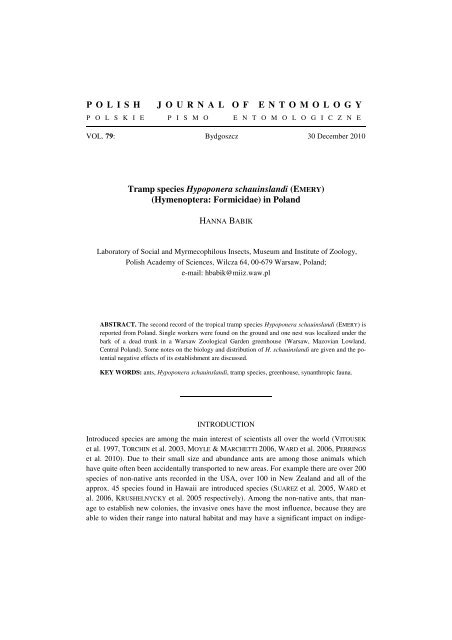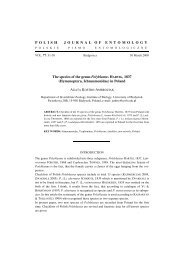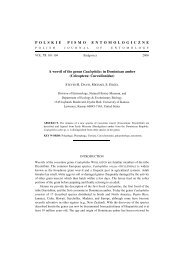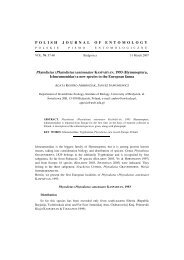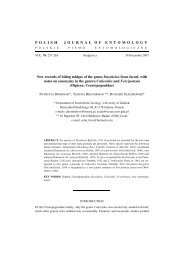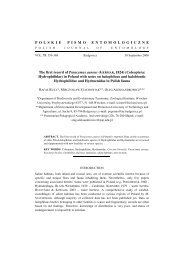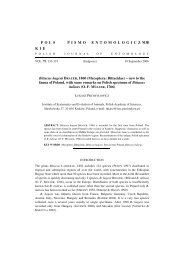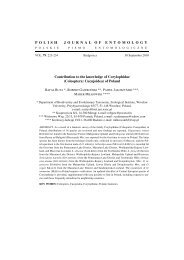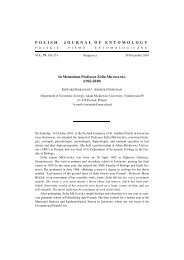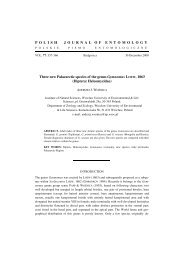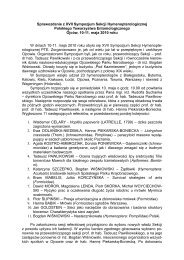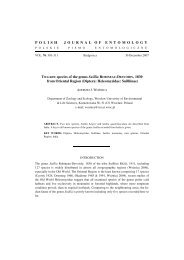(EMERY) (Hymenoptera: Formicidae) - Polskie Towarzystwo ...
(EMERY) (Hymenoptera: Formicidae) - Polskie Towarzystwo ...
(EMERY) (Hymenoptera: Formicidae) - Polskie Towarzystwo ...
You also want an ePaper? Increase the reach of your titles
YUMPU automatically turns print PDFs into web optimized ePapers that Google loves.
P O L I S H J O U R N A L O F E N T O M O L O G YP O L S K I E P I S M O E N T O M O L O G I C Z N EVOL. 79: Bydgoszcz 30 December 2010Tramp species Hypoponera schauinslandi (<strong>EMERY</strong>)(<strong>Hymenoptera</strong>: <strong>Formicidae</strong>) in PolandHANNA BABIKLaboratory of Social and Myrmecophilous Insects, Museum and Institute of Zoology,Polish Academy of Sciences, Wilcza 64, 00-679 Warsaw, Poland;e-mail: hbabik@miiz.waw.plABSTRACT. The second record of the tropical tramp species Hypoponera schauinslandi (<strong>EMERY</strong>) isreported from Poland. Single workers were found on the ground and one nest was localized under thebark of a dead trunk in a Warsaw Zoological Garden greenhouse (Warsaw, Mazovian Lowland,Central Poland). Some notes on the biology and distribution of H. schauinslandi are given and the potentialnegative effects of its establishment are discussed.KEY WORDS: ants, Hypoponera schauinslandi, tramp species, greenhouse, synanthropic fauna.INTRODUCTIONIntroduced species are among the main interest of scientists all over the world (VITOUSEKet al. 1997, TORCHIN et al. 2003, MOYLE & MARCHETTI 2006, WARD et al. 2006, PERRINGSet al. 2010). Due to their small size and abundance ants are among those animals whichhave quite often been accidentally transported to new areas. For example there are over 200species of non-native ants recorded in the USA, over 100 in New Zealand and all of theapprox. 45 species found in Hawaii are introduced species (SUAREZ et al. 2005, WARD etal. 2006, KRUSHELNYCKY et al. 2005 respectively). Among the non-native ants, that manageto establish new colonies, the invasive ones have the most influence, because they areable to widen their range into natural habitat and may have a significant impact on indige-
Polish Journal of Entomology 79 (3)L. neglectus on the other hand establishes numerous colonies in urban greenery (VAN LOONet al. 1990). The remaining five species [H. schauinslandi, Linepithema humile MAYR,Monomorium pharaonis (L.), Tetramorium insolens (F. SMITH) and T. caldarium (ROGER)]are strictly synanthropic, found only indoors, in spaces where constant favourable climaticconditions are maintained. From among these species so far only M. pharaonis has becomea pest in Poland (see e.g. BRODNIEWICZ et al. 1979, GLINIEWICZ et al. 2003, 2006).Species with a cryptic mode of life, like H. schauinslandi, are among the most commontramp and invasive ants in the world (MCGLYNN 1999). H. schauinslandi is found in manyEuropean countries, although to the north of 48ºN latitude it is able to survive only indoors(SEIFERT 2003, 2007). As its dispersion over the long distances depends on passive transport,e.g. with tropical plants, it occurs mainly in greenhouses of botanical and zoologicalgardens, where sometimes it becomes quite common. For example BOER & VIERBERGEN(2008) consider it as “the most successful exotic ant in Dutch greenhouses” present in everytropical greenhouse and exotic animal house with tropical and subtropical plants investigatedby the authors.However, H. schauinslandi is not considered as threat to native flora and fauna in theCentral and Northern Europe. It is not able to fly over long distances or establish permanentcolonies in natural habitats (SEIFERT 2003, 2007, DEKONINCK et al. 2006, BOER & VIER-BERGEN 2008). It is also not likely to become a common indoor pest beyond greenhouses,because of its predatory behaviour. Nevertheless, BOER & VIERBERGEN (2008) mentionedsome recorded findings in houses in the Netherlands and GRAY et al. (1995) reported thepresence of H. punctatissima, also a predatory species, in a hospital in England. A possibleproblem exists because during dispersal flights young queens may sting painfully (BOER &VIERBERGEN 2008).Although many introduced ant species never managed to establish permanent coloniesin new places there is an urgent need to monitor exotic species in new habitats, as they mayhave a strong impact on natural ecosystems as well as human health and economy. Thetropical, predatory species H. schauinslandi, is not likely to become a pest in Poland, howeverits presence is a reason for paying more attention to exotic species, accidentally transportedby human.AcknowledgementsI would like to thank Michalina KAMUT, a student at the University of Warsaw, forhelping in the field study. I am deeply indebted to Prof. Wojciech CZECHOWSKI, forencouragement and valuable consultationsREFERENCESBOER P., VIERBERGEN B. 2008. Exotic ants in The Netherlands (<strong>Hymenoptera</strong>: <strong>Formicidae</strong>). EntomologischeBerichten 68: 121-129.
BABIK H.:BRODNIEWICZ A. 1979. Studia nad infestacją budynków i mieszkań przez szkodniki sanitarne naterenie m. st. Warszawy. Prace i materiały Techniczno-Ekonomicznej Rady Naukowej przyPrezydencie m. st. Warszawy, Sekcja 4, Warszawa, 126 pp.COLLINGWOOD C.A. 1979. The <strong>Formicidae</strong> (<strong>Hymenoptera</strong>) of Fennoscandia and Denmark. FaunaEntomologica Scandinavica 8: 1-174.CREMER S., UGELVIG L.V., LOMMEN S.T.E., PETERSEN K.S., PEDERSEN J.S. 2006. Attack of the invasivegarden ant: aggression behaviour of Lasius neglectus (<strong>Hymenoptera</strong>: <strong>Formicidae</strong>) against nativeLasius species in Spain. Myrmecologische Nachrichten 9: 13-19.CZECHOWSKI W., CZECHOWSKA W. 1999. New data on the occurrence of ants of the subfamily Ponerinae(<strong>Hymenoptera</strong>, <strong>Formicidae</strong>) in Poland. Fragmenta Faunistica 42: 7-10.CZECHOWSKI W., RADCHENKO A., CZECHOWSKA W. 2002. The ants (<strong>Hymenoptera</strong>, <strong>Formicidae</strong>) ofPoland. Museum and Institute of Zoology PAS, Warszawa, 200 pp.DEKONINCK W., MAELFAIT J.P.,VANKERKHOVEN F., BAUGNE J.Y., GROOTAERT P. 2006. An update ofthe checklist of the Belgian ant fauna with comments on new species for the country (<strong>Hymenoptera</strong>,<strong>Formicidae</strong>). Belgian Journal of Entomology 8: 27-41.GLINIEWICZ A., SAWICKA B., CZAJKA E. 2003. Ocena zagrożenia i możliwości zwalczania owadówszkodników sanitarnych w szpitalach w Polsce. Przegląd Epidemiologiczny 57: 329-334.GLINIEWICZ A., SAWICKA B., MIKULAK E. 2006. Pest control and pesticide use in hospitals in Poland.Indoor and Built Environment 15: 57-61.GRAY K.J., PORTER C., HAWKEY P.M., COMPTON S.G., EDWARDS J.P. 1995. Roger's ant: a new pestin hospitals. British Medical Journal 311: 129.HÖLLDOBLER B., WILSON E.O. 1990. The ants. Harvard University Press, Cambridge Mass., xii + 732pp.JOURDAN H., SADLIER R.A., BAUER A.M. 2001. Little fire ant invasion (Wasmannia auropunctata) asa threat to New Caledonian lizards: evidences from a Sclerophyll Forest (<strong>Hymenoptera</strong>: <strong>Formicidae</strong>).Sociobiology 38: 283-302.KRUSHELNYCKY P.D., LOOPE L.L., REIMER N.J. 2005. The ecology, policy, and management of antsin Hawaii. Proceedings of the Hawaiian Entomological Society 37: 1-25.LEE C.Y. 2002. Tropical household ants: pest status, species diversity, foraging behavior and baitingstudies. [in:] S.C. Jones, J. ZHAI, W.H. ROBINSON (eds) Proceedings of the 4 th International Conferenceon Urban Pests. Pocahontas Press, Blacksburg, Virginia, USA, pp. 3-18.LESSARD J-P., FORDYCE J.A., GOTELLI N.J., SANDERS N.J. 2009. Invasive ants alter the phylogeneticstructure of ant communities. Ecology 90: 2664-2669.MCGLYNN T.P. 1999. The worldwide transfer of ants: geographical distribution and ecological invasions.Journal of Biogeography 26: 535-548.MOYLE P.B., Marchetti M.P. 2006. Predicting invasion success: freshwater fishes in California as amodel. Bioscience 56: 515-524.NASONOV N.V. 1892. K faune murav'ev Rossii. (K faune Privislyanskogo Kraya.). Izvestiya VarshavskagoUniversiteta 5: 1-14.NOWOTNY M.P. 1937. Nachtrag zur Ameisenfauna Oberschlesisen. Zeitschrift für Entomologie 18:5-6.PASSERA L. 1994. Characteristics of tramp ants. [in:] D. WILLIAMS (ed.) Exotic ants. Westview Press,Boulder, pp. 23-43.PERRINGS C., MOONEY H., WILLIAMSON M. 2010. Bioinvasions & globalization. Ecology, economics,management and policy. Oxford University Press, Oxford, 267 pp.PEETERS C., HÖLLDOBLER B. 1992. Notes on the morphology of the sticky “doorknobs” of larvae inan Australian Hypoponera sp. (<strong>Formicidae</strong>; Ponerinae). Psyche 99: 23-30.PISARSKI B. 1957. O występowaniu egzotycznych gatunków mrówek w Polsce. Fragmenta Faunistica7: 283-289.
Polish Journal of Entomology 79 (3)PISARSKI B. 1982. Ants of Warsaw and Mazovia. In: Species composition and origin of the fauna ofWarsaw. 3. Memorabilia Zoologica 36: 73-90.PISARSKI B., CZECHOWSKI W. 1978. Influence de la pression urbaine sur la myrmécofaune. MemorabiliaZoologica 29: 109-128.RADCHENKO A., CZECHOWSKA W., CZECHOWSKI W. 2004. Mrówki – <strong>Formicidae</strong>. Klucze do OznaczaniaOwadów Polski, XXIV, 63. <strong>Polskie</strong> <strong>Towarzystwo</strong> Entomologiczne, Toruń, 138 pp.ROGER J. 1859. Beiträge zur Kenntnis der Ameisenfauna der Mittelmeerländer. Berliner EntomologischeZeitschrift 3: 225-259.RÜGER M.H., FRÖBA J., FOITZIK S. 2008. Larval cannibalism and worker-induced separation of larvaein Hypoponera ants: a case of conflict over caste determination? Insectes Sociaux 55: 12-21.SEIFERT B. 2003. Hypoponera punctatissima (ROGER) and H. schauinslandi (<strong>EMERY</strong>) – Two morphologicallyand biologically distinct species (<strong>Hymenoptera</strong>: <strong>Formicidae</strong>). Abhandlungen und Berichtedes Naturkundemuseums Görlitz 75: 61-81.SEIFERT B. 2007. Die Ameisen Mittel- und Nordeuropas. Lutra-Verlags- und Vertriebsgesellschaft,Görlitz, 368 pp.SUAREZ A.V., HOLWAY D.A., WARD P.S. 2005. The role of opportunity in the unintentional introductionof nonnative ants. Proceedings of the National Academy of Science USA 102: 17032-17035.TORCHIN M.E., LAFFERTY K.D., DOBSON A.P., MCKENZIE V.J., KURIS A.M. 2003. Introduced speciesand their missing parasites. Nature 421: 628-630.VAN LOON A.J., BOOMSMA J.J., ANDRÁSFALVY A. 1990. A new polygynous Lasius species (<strong>Hymenoptera</strong>:<strong>Formicidae</strong>) from Central Europe. Insectes Sociaux 37: 348-362.VITOUSEK P.M., D'ANTONIO C.M., LOOPE L.L., REJMÁNEK M., WESTBROOKS R. 1997. Introducedspecies: a significant component of human-caused global change. New Zealand Journal of Ecology21: 1-16.WARD D.F., BEGGS J.R., CLOUT M.N., HARRIS R.J., O'CONOR S. 2006. The diversity and origin ofexotic ants arriving in New Zealand via human-mediated dispersal. Diversity and Distributions12: 601-609.WETTERER J.K. 2010. Worldwide spread of the pharaoh ant, Monomorium pharaonis (<strong>Hymenoptera</strong>:<strong>Formicidae</strong>). Myrmecological News 13: 115-129.YAMAUCHI K., KIMURA Y., CORBARA B., KINOMURA K., TSUJI K. 1996. Dimorphic ergatoid males andtheir reproductive behavior in the ponerine ant Hypoponera bondroiti. Insectes Sociaux 43: 119-130.Received:Accepted:


